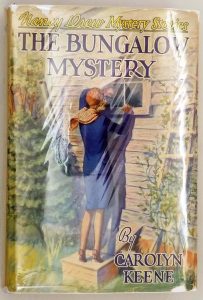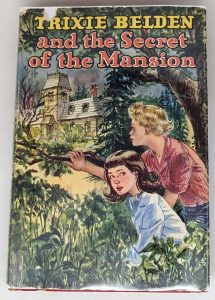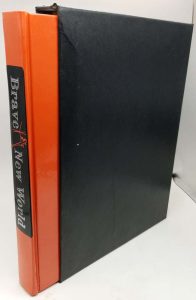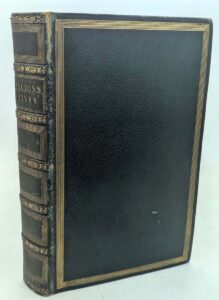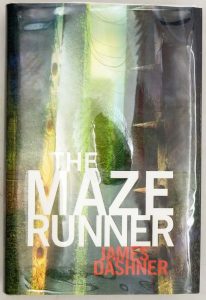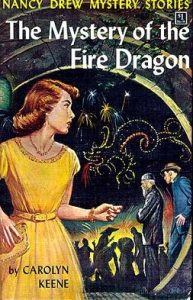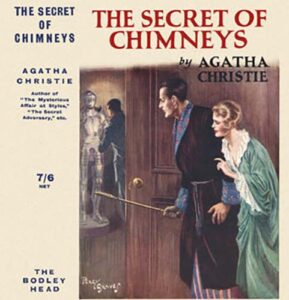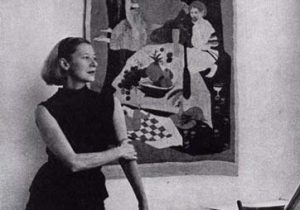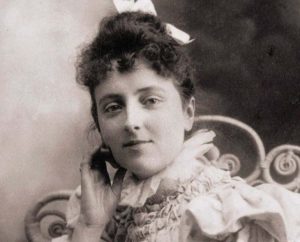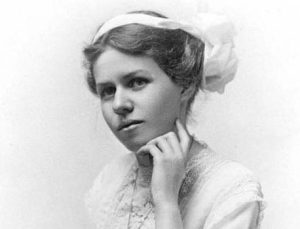The Wonderful Wizard of Oz is an American children’s novel written by author L. Frank Baum and illustrated by W. W. Denslow. The first novel in the Oz books, the Kansas farm girl named Dorothy ends up in the magical Land of Oz after she and her pet dog Toto are swept away from their home by a tornado. Upon her arrival in Oz, she learns she cannot return home until she has destroyed the Wicked Witch of the West.
The book was first published in the United States in May 1900 by the George M. Hill Company. In January 1901, the publishing company completed printing the first edition, a total of 10,000 copies, By October 1900, it had already sold out and the second edition of 15,000 copies was nearly depleted. It had sold three million copies by the time it entered the public domain in 1956. It was often reprinted under the title The Wizard of Oz, which is the title of the successful 1902 Broadway musical adaptation as well as the classic 1939 live-action film.
The ground-breaking success of both the original 1900 novel and the 1902 Broadway musical prompted Baum to write thirteen additional Oz books which serve as official sequels to the first story. Over a century later, the book is one of the best-known stories in American literature, and the Library of Congress has declared the work to be “America’s greatest and best-loved homegrown fairytale.”
Summary
Dorothy is a young girl who lives with her Aunt Em, Uncle Henry, and dog, Toto, on a farm on the Kansas prairie. One day, she and Toto are caught up in a cyclone that deposits them and the farmhouse into Munchkin Country in the magical Land of Oz. The falling house has killed the Wicked Witch of the East, the evil ruler of the Munchkins. The Good Witch of the North arrives with three grateful Munchkins and gives Dorothy the magical silver shoes that once belonged to the Wicked Witch. The Good Witch tells Dorothy that the only way she can return home is to follow the yellow brick road to the Emerald City and ask the great and powerful Wizard of Oz to help her. As Dorothy embarks on her journey, the Good Witch of the North kisses her on the forehead, giving her magical protection from harm.
On her way down the yellow brick road, Dorothy attends a banquet held by a Munchkin named Boq. The next day, she frees a Scarecrow from the pole on which he is hanging, applies oil from a can to the rusted joints of a Tin Woodman, and meets a Cowardly Lion. The Scarecrow wants a brain, the Tin Woodman wants a heart, and the Lion wants courage, so Dorothy encourages them to journey with her and Toto to the Emerald City to ask for help from the Wizard.
After several adventures, the travelers arrive at the Emerald City and meet the Guardian of the Gates, who asks them to wear green tinted spectacles to keep their eyes from being blinded by the city’s brilliance. Each one is called to see the Wizard. He appears to Dorothy as a giant head, to the Scarecrow as a lovely lady, to the Tin Woodman as a terrible beast, and to the Lion as a ball of fire. He agrees to help them all if they kill the Wicked Witch of the West, who rules over Winkie Country. The Guardian warns them that no one has ever managed to defeat the witch.
The Wicked Witch of the West sees the travelers approaching with her one telescopic eye. She sends a pack of wolves to tear them to pieces, but the Tin Woodman kills them with his axe. She sends a flock of wild crows to peck their eyes out, but the Scarecrow kills them by twisting their necks. She summons a swarm of black bees to sting them, but they are killed while trying to sting the Tin Woodman while the Scarecrow’s straw hides the others. She sends a dozen of her Winkie slaves to attack them, but the Lion stands firm to repel them. Finally, she uses the power of her Golden Cap to send the Winged Monkeys to capture Dorothy, Toto, and the Lion, unstuff the Scarecrow, and dent the Tin Woodman. Dorothy is forced to become the witch’s personal slave, while the witch schemes to steal her silver shoes.
The witch successfully tricks Dorothy out of one of her silver shoes. Angered, she throws a bucket of water at the witch and is shocked to see her melt away. The Winkies rejoice at being freed from her tyranny and help restuff the Scarecrow and mend the Tin Woodman. They ask the Tin Woodman to become their ruler, which he agrees to do after helping Dorothy return to Kansas. Dorothy finds the witch’s Golden Cap and summons the Winged Monkeys to carry her and her friends back to the Emerald City. The King of the Winged Monkeys tells how he and his band are bound by an enchantment to the cap by the sorceress Gayelette from the North, and that Dorothy may use it to summon them two more times.
When Dorothy and her friends meet the Wizard again, Toto tips over a screen in a corner of the throne room that reveals the Wizard, who sadly explains he is a humbug—an ordinary old man who, by a hot air balloon, came to Oz long ago from Omaha. He provides the Scarecrow with a head full of bran, pins, and needles (“a lot of bran-new brains”), the Tin Woodman with a silk heart stuffed with sawdust, and the Lion a potion of “courage”. Their faith in his power gives these items a focus for their desires. He decides to take Dorothy and Toto home and then go back to Omaha in his balloon. At the send-off, he appoints the Scarecrow to rule in his stead, which he agrees to do after helping Dorothy return to Kansas. Toto chases a kitten in the crowd and Dorothy goes after him, but the ropes holding the balloon break and the Wizard floats away.
Dorothy summons the Winged Monkeys and tells them to carry her and Toto home, but they explain they can’t cross the desert surrounding Oz. The Soldier with the Green Whiskers informs Dorothy that Glinda, the Good Witch of the South may be able to help her return home, so the travelers begin their journey to see Glinda’s castle in Quadling Country. On the way, the Lion kills a giant spider who is terrorizing the animals in a forest. They ask him to become their king, which he agrees to do after helping Dorothy return to Kansas. Dorothy summons the Winged Monkeys a third time to fly them over a hill to Glinda’s castle.
Glinda greets them and reveals that Dorothy’s silver shoes can take her anywhere she wishes to go. She embraces her friends, all of whom will be returned to their new kingdoms through Glinda’s three uses of the Golden Cap: the Scarecrow to the Emerald City, the Tin Woodman to Winkie Country, and the Lion to the forest; after which the cap will be given to the King of the Winged Monkeys, freeing him and his band. Dorothy takes Toto in her arms, knocks her heels together three times, and wishes to return home. Instantly, she begins whirling through the air and rolling on the grass of the Kansas prairie, up to the farmhouse, though the silver shoes fall off her feet en route and are lost in the Deadly Desert. She runs to Aunt Em, saying “I’m so glad to be home again!”
Frank Baum – The Wonderful Wizard of Oz | First Edition Identification Guide
Please refer to the gallery for detailed images of binding(s) and dust jackets.
| Year | Title | Publisher | First edition/printing identification points |
|---|---|---|---|
| 1900 | The Wonderful Wizard of Oz | Geo M. Hill Co., 1900 | First edition. illustrated by W. W. Denslow, 261 pages. Two states, priority as listed: 1- Textual points: Page [2]: the publisher’s advertisement is enclosed in a box; page 14, line 1 has: “low wail on..."; page 81, fourth line from bottom has; “peices”; page [227], line 1 begins: “While Tin Woodman..."; the colophon at the end of the book is set in eleven lines and is enclosed in a box. Pictorial self-endpapers; the front paste-down endpaper is in black and gray, the back paste-down endpaper is black and red. The pages facing the pastedowns are blank.*Color plates: 24 full-color, tipped-in inserts: title page and facing pages 14f, 20, 34, 36, 44, 56, 66, 80, 92,102, 114, 126, [138], 150, 160, 170, 184, 198, 212, 220, 228, 246, 254. The verso of the inserted title page is blank or has a rubber-stamped copyright notice. The color plate facing page 34 has two dark-blue blots on the moon, and the plate facing page 92 has red shading on the horizon. Binding: light-green cloth, stamped in red and green on the front, back, and spine. Three variants, the publisher’s imprint at the foot of the spine occurs in one of the following forms: A) In plain, unserifed type, stamped in green; the “CO.” is set in ordinary fashion. B) Same as variant A except stamped in red. C) In serifed type, stamped in red; the “C” of “Co.” encircles the “o”. The green spine imprint (variant A) is associated with the earliest dated presentation copies. All later bindings apparently have red imprints. Variant B seems to have preceded C; variant C, which was used for an extended period, is the form most commonly found on later printings. Dust jacket: Printed in dark green on pea-green stock. The jacket design is a monochrome version of the binding design. The publisher’s imprint on the jacket is in unserifed type. The front and back flaps are blank. Size of leaf: 8 3/8 by 6 3/8 inches. Thickness of volume:. 1 3/16 inches. 2- Textual points: Page [2]: the publisher’s advertisement has no box; page 14: “low wail of..page 81: “pieces”; page [227]: “While The Woodman...”; the colophon is reset in 13 lines with no box. Color plates: The verso of the title page has a press-printed copyright notice. The color plates are the same as those of the first state except that the dark-blue blots have been removed from the moon on the plate facing page 34 and the red shading on the horizon has been removed from the plate facing page 92. Binding: Usually variant C described above. NOTE: Additional binding variants have been reported, but most differ only slightly from C. However, copies of a binding believed to be very late (as evidenced by plate wear) have been seen with the publisher’s imprint on the spine stamped in red letters, similar to those of binding variant B. Another late binding, with spine imprint C, drops “THE” from the book’s title on the spine. |
| 1903 | The New Wizard of Oz | Indianapolis: The Bobbs-Merrill Co., [1903] | Second edition. For this edition, W. W. Denslow supplied new cover, title page, and endpaper drawings. Nine of the original color plates, including the original title page, were dropped. There are two states and a number of minor variants. Priority as listed: Textual points: Page 49: the illustration is 2 7/8 inches below the text. The text illustrations are printed in the following color sequence: red (pages [5]-111), green (113- 144), red (145-175), green ([177]-222), red ([225]-[261]). On page 167, line 9, the woids “yellow daisies” of the Hill printings have become “bright daisies”, and on page 168, lines 2 and 11, the original “yellow flowers” and “yellow fields” have been changed to “scarlet flowers” and “scarlet fields”. Inserted pictorial endpapers in green and orange. One copy, probably a binder’s error, has been seen with blank endpapers. Color plates: 16 full-color tipped-in inserts, including a new title page. The other plates face pages 20, 34, 44, 56, 66, 92, 102, 114, [138], 160, 170, 184, 198, 228, 254.
The captions on the color plates are newly set in an italic type that differs from that of the Hill captions most noticeably in the letters “f”, “s”, and “y”. The caption on the plate facing page 56 omits a single quotation mark. Binding: dark-green cloth stamped in black and orange. The full title appears on the front cover and on the spine: The New Wizard of Oz. The back cover has an illustration of the Tin Woodman stamped in black, and the spine has a drawing of the Cowardly Lion in black and orange. There is a period after the author’s name on the spine. The crow’s eye on the front cover is in orange. The publisher’s imprint on the spine reads: “THE BOBBS | MERRILL | CO.” Size of leaf: 9 1/16 by 6 7/8 inches. Thickness of volume'. 11/8 inches. Textual points: Same as #1 except that the color sequence of the text illustrations has been changed. Graygreen (pages [5]-16) blue-green ([17]-79), red (82-96), green ([97]-144), yellow (145-175), green ([177]-222), brown ([225]-239), red ([243]-[261]). Color plates: Same as # 1 except that the copyright notice, printed in black on the verso of the title page, has three entries in the center, in slightly different type from entries A and B described above. “Copyright, 1899, I By L. FRANK BAUM and W.W. DENSLOW. | ' All rights reserved. | [rule] | Copyright, 1903, | By THE BOBBS-MERRILL COMPANY. | [rule] | Copyright, 1903, | By L. FRANK BAUM and W.W. DENSLOW.” NOTE: Apparently no major changes were made in the book until 1913 when Bobbs-Merrill leased the plates to another publisher. However, the following minor variants of the second state of the second edition have been reported and are recorded in logical sequence:
Because of the many components involved and because the book was kept continuously in print, copies may be found with one or more of the above variations present. The checklist authors will be interested in learning of still other changes. Probably to secure British copyright, Bobbs-Merrill sent copies of its first printing to the Advocates' Library in Edinburgh, the British Museum in London (received July 29, 1903), and the Bodleian Library in Oxford (received August 13, 1903). The three copies differ from examples of # 1 found in America in that they have endpapers printed only in green.* The verso of the title page has the single-entry copyright notice. |
| 1906 | London: Hodder & Stoughton., 1903 [1906] | First UK edition. The contents are identical with the Bobbs-Merrill second edition, second state, except that the British publisher’s name has been added on the title page beneath the American one; the verso has the three-entry copyright notice. The book is bound in light-green cloth, stamped in black, dark peach, and dark green, with the Hodder & Stoughton imprint on the spine. The cover illustrations are the same as those on the American version. | |
| 1913 | The New Wizard of Oz | M.A. Donohue, [1903] ca. 1913 | Third edition. In 1913 Bobbs-Merrill leased the printing plates of The New Wizard of Oz to M.A. Donohue, a reprint publisher. There are many Donohue variants, all of which fall into one of the major states described below. Textual points: Similar to a late Bobbs-Merrill #2, with all of the type degeneration mentioned above, except that the correct lion is restored to page [63]. The colors of the text illustrations differ from those of Bobbs-Merrill #2: red, green, brown, olive-green, and yellow are printed without relation to the scheme of the story. The earliest reported Donohue copy has no additional resetting of type. Shortly thereafter page 14 was completely reset Later copies lack the running title on page 44. Still later, pages 68 and 89 were reset, and the running titles on pages 44 and 49 were reset. Color plates: The copyright notice (on the verso of the color-insert title page) is identical with the three-entry Bobbs- Merrill variant but without the printer’s imprint All 16 color plates (including the title page) are present In earliest copies they are tipped in; in later copies they are bound in. The Donohue imprint replaces the Bobbs- Merrill imprint on the title page. 2- Textual points: Color has been omitted from half of the text illustrations. Earlier copies have the textual illustrations on pages [195]-[261] in orange; later copies have these pages in brown. Apparently still later the picture of a witch's hat was deleted from page [ 137]. At least one late printing omits the color background from the Introduction page. Color plates: All the color plates have been omitted except a double-faced frontispiece conjugate with the title page. The illustrations on both faces of the frontispiece vary; the following have been reported: "This is a great comfort,’ said the Tin Woodman. ’/“The Stork carried him up into the air. ” Some copies have this frontispiece printed in blue, light blue, and yellow; others have it printed in blue and yellow only. “You must give me the Golden Cap. ’’/“Permit me to introduce you to her Majesty, the Queen. ’’ Printed in blue and yellow. “I am the Witch of the North. ’’/“The Monkeys caught Dorothy in their arms and flew away with her.” Printed in blue and yellow. “ T was only made yesterday, ’said the Scarecrow. ’/“You ought to be ashamed of yourself!’’ Printed in blue and yellow. Binding: The cover cloth is usually dark green, but several shades of green and blue have been seen. The back cover is blank. One copy has been reported with stamped white decorations on the Scarecrow on the front cover.
|
| 1920 | The New Wizard of Oz | Indianapolis: The Bobbs-Merrill Co., [1903] ca. 1920 | Fourth edition. Textual points: All the reset type noted in the Donohue printings is present In addition, the “list of chapters.” heading on page [7] and the running titles on pages 222 and 234 have teen reset Page [137] has a crude re-drawing of the witch’s hat. All the text illustrations are once again in color, but the color sequence differs from earlier printings: tan (pages [5]-[65]), yellow (68-129), green (131-[193]), red ([195]-[261]). The inserted endpapers are blank. Color plates: Title page printed in full color, similar to early Bobbs-Merrill printings; the verso has an added line, “Printed in the United States of America”, above the printer’s imprint The other 15 full-color inserts have been reinstated, with reset captions.There is a misprint on the last color plate: “Cup” for “Cap”. A double-page frontispiece precedes the title page; a black-and-white photograph of Fred Stone, and a letter from Stone, “To My Little Friends:”, facing it. |
| 1920- | The New Wizard of Oz | The Bobbs-Merrill Co., [1903] cprinted in 1920s-1930s | Fifth edition. Two states, unknown priority: 1- Textual points: The text has been entirely reset, and most of the text illustrations have been removed. The few that remain are in black and white. These changes result in a book of only 208 pages. Color plates: 16 full-color inserts, including the title page. Binding: Normally dark-green cloth. The pictorial paper label and the stamping are similar to the fourth edition. Some copies have tan or yellow replacing the dark blue of the cover label. |
| 1934 | The Wizard of Oz Waddle Book | Blue Ribbon Books, 1934 | This Waddle Book contains 6 die-cut “Waddle Toys*’ which when assembled would waddle down a sloping cardboard, yellow brick road runway which was enclosed in an inserted envelope held to the back cover of the book by a 4-inch wide decorated paper band. Copies with the Waddles are rarely found, and thus the states of the book are difficult to determine, but the following seems to be the pattern. Two states, probable priority: 1- Textual points: Similar to the fifth edition, second state, with the following changes: there is a new title page; an additional entry is included at the end of the contents page for instructions to assemble the Waddles; and pages [209]- [211] give the instructions. Color plates and inserts: 8 color plates with text printed on the versos. The punch-out Waddle figures are printed on sheets of heavy card stock which are tipped to bound-in perforated stubs between pages 46/47, 94/95, and 143/ 144; the wraparounds of the stubs emerge at pages 55/56, 102/103, 150/151. Binding: Light green cloth with a flat spine. The front has a new label showing the Waddles waddling. The spine has an imprint for Blue Ribbon Books at the foot. The back is blank. Textual points: Same as # 1.Color plates and inserts: Same as # 1 except that the Waddles are not attached to stubs but enclosed in the envelope containing the runway. The paper stubs, however, seem to be retained, at least in some copies. Binding: same as # 1 except that it is light olive cloth with a rounded spine, and there is no publisher’s imprint at the foot of the spine. After the plates were returned to Bobbs-Merrill, some printings of The New Wizard of Oz continued to have the additional Waddle entry on the contents page. These copies, printed between 1935 and 1939, are bound in a much lighter green cloth than previous printings of the fifth edition. Several copies have been reported with text on the back of the color plates, as in the Waddle edition. |
| 1939 | The New Wizard of Oz | Indianapolis: The Bobbs-Merrill Co., [1903] 1939 | MGM Movie edition. Two states: 1- Textual points: Same as copies of the fifth edition from the later 1930s, except that the erroneous Waddle entry from the contents page has been omitted and the book has inserted endpapers reproducing stills in sepia from the MGM movie, The Wizard of Oz. Color plates: 8 color plates with black replacing the blue of earlier printings. Binding: light green or medium-dark green cloth, stamped on the front in black and on the spine in black and gold; the spine has black fields behind the printing. The back cover is blank. Issued in a pictorial dust jacket (plate 9). Size of leaf: The book is larger than earlier printings; the page size is 9 5/8 by 7 inches. 2-Textual points, color plates and cover: Same as #1 except that the endpapers are blank and that there are no black fields on the spine. Copies have been seen bound in light green and in medium-dark green cloth. The release of the MGM movie The Wizard of Oz in 1939 resulted in the first rewritten versions of the story. Because they do not contain L. Frank Baum’s wordings, they are adaptations rather than abridgments. The following books are the first editions of the story to have pictures by illustrators other than Denslow. |
| 1939 | The Wizard of Oz Picture Book | Racine: Whitman Publishing Co., 1939 | Illustrated by Leason. 12 unnumbered pages, including the covers. Textual points and binding: Made up of a single gathering, saddle wire-stitched (stapled in the center). The front and back wrappers (plate 10) are trimmed to page size and printed on the same textured stock as the contents, and the story begins on the verso of the front cover and ends on the recto of the back cover. The top three-fourths of each page contains a full-color illustration. Size of leaf: 12 1/2 by 8 5/8 inches. Thickness of volume: 3/32 inch. |
Frank Baum – The Wonderful Wizard of Oz | First Edition Dust Jacket Identification
First edition binding(s) and various Dust Jacket printings identification.
Reference:
- Wikipedia
- Bibliographia Oziana – Haff, Greeme, Martin. 2002
